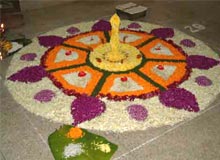 Kolam is the name given to the art of Rangoli in southern parts of the country, mainly the states of Kerala and Tamil Nadu. The Hindus residing in these parts make use of this art form on a large scale. The female members of the house usually draw Kolam designs in front of their homes, with the help of rice powder. Limestone and red brick powder are also used on special occasions. Kolam is regarded as a sort of painted prayer in South India. The design usually comprises of a symmetric line drawing, which comprises of curved loops, drawn around a crisscross pattern of dots.
Kolam is the name given to the art of Rangoli in southern parts of the country, mainly the states of Kerala and Tamil Nadu. The Hindus residing in these parts make use of this art form on a large scale. The female members of the house usually draw Kolam designs in front of their homes, with the help of rice powder. Limestone and red brick powder are also used on special occasions. Kolam is regarded as a sort of painted prayer in South India. The design usually comprises of a symmetric line drawing, which comprises of curved loops, drawn around a crisscross pattern of dots.In a South-Indian home, it is believed Kolam design bestows prosperity and success. Though the design is generally drawn with the help of dry rice flour, diluted rice paste is also made use of, especially when one intends to signify longevity. At times, paints and chalks are also used to draw the design. In case of special occasions, such as marriages, ritual Kolam patterns can stretch all the way from the courtyard to the street. The patterns are often passed on from generation to generation, like from a mother to her daughter. Though less ostentatious than Rangoli, Kolam art of Tamil Nadu and Kerala is considered as outstanding in its beauty.
Everyday Kolam Ritual
In South India, making Kolam designs is an everyday ritual. Since the one drawn on the previous day gets walked on or rained out or blown away, new ones are made on a daily basis. The womenfolk of the household get up every morning before sunrise and clean the floor with water. Thereafter, the design is made on the damp surface, where it holds better. It is said that in a Kolam design, the lines must be completed. Unbroken lines prevent evil spirits from entering inside the design, and along with it, inside the home.
Traditional Significance of Kolam
Apart from being used for decoration, Kolam serves other purposes also. One of the uses of Kolam is to provide food to the ants. Since the designs are made with the help of coarse rice flour, they provide an easy as well as readily available source of food supply for the ants. At the same time, it is said that rice powder attracts birds and other small critters. Thus, the design is a sort of invitation to all, especially Goddess Lakshmi - the Goddess of prosperity, into one's home and everyday life.
Then, there are health benefits of Kolam. Since one has to bend down to make the pattern, it brings about an improvement in the digestive system and reproductive organs and also serves as an overall stretching exercise for the body. The ability to draw large complicated patterns without lifting the hand off the floor or unbending to stand up is believed to be a matter of pride for the South Indians.
1 comment:
very good rangoli its a real culture of india good job dear..........
Cheap Flights to Vancouver|Cheap Flights to Los Angeles
Post a Comment